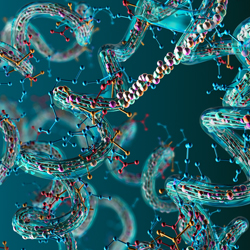Understanding and Harnessing Assembly Processes in Biological Materials and Biomimetics
 This Special Topic highlights multidisciplinary efforts in the investigation of natural and biomimetic molecular systems, with emphasis on molecular assembly for the generation of extended structures leading to function. Fascinated by the emergence of biological functionalities from the structure and arrangement of molecules extending in physical space or in time, studies in this area attempt to decipher the assembly processes observed in nature or harness these mechanisms in order to make new materials.Self-assembly gives rise to myriad subcellular structures from lipid-membranes to protein complexes, such as adhesive plaques and nucleopores. Beyond local ordering, assembly also leads to biomechanical superstructures, such as shells and bone. Structural dynamics can be implemented by active systems, as in the cytoskeleton or in dynamic chemical cycles of biomimetic assemblies. Dynamics can also be imprinted in the materials architecture, as in the elasticity of actuating wood and self-healing glues. Recent progress has been propelled by both refinements in conventional characterization methods and development of new techniques, including computational modeling and AI driven data analyses.
This Special Topic highlights multidisciplinary efforts in the investigation of natural and biomimetic molecular systems, with emphasis on molecular assembly for the generation of extended structures leading to function. Fascinated by the emergence of biological functionalities from the structure and arrangement of molecules extending in physical space or in time, studies in this area attempt to decipher the assembly processes observed in nature or harness these mechanisms in order to make new materials.Self-assembly gives rise to myriad subcellular structures from lipid-membranes to protein complexes, such as adhesive plaques and nucleopores. Beyond local ordering, assembly also leads to biomechanical superstructures, such as shells and bone. Structural dynamics can be implemented by active systems, as in the cytoskeleton or in dynamic chemical cycles of biomimetic assemblies. Dynamics can also be imprinted in the materials architecture, as in the elasticity of actuating wood and self-healing glues. Recent progress has been propelled by both refinements in conventional characterization methods and development of new techniques, including computational modeling and AI driven data analyses.
Research into the molecular nature and complexity of biological and bioinspired systems is also enabled by collaborations across diverse fields, such as molecular biology, structural biology, biophysics, polymer and materials science, supramolecular chemistry, computation, biointerfaces, etc. Synergies between research into biological materials and bioinspired systems will advance our understanding of underlying biomolecular principles. Harnessing these principles for advanced materials development is poised to deliver critical innovations for the 21st century from novel biomedicine to sustainability applications.
Biophysics Reviews Editor
K.H. Aaron Lau, University of Strathclyde
Guest Editors
Yael Politi, TU Dresden
